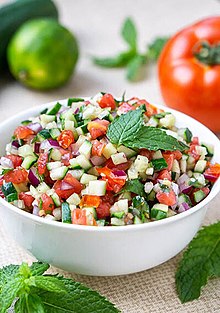|
'''Shirazi salad''' ({{lang-fa|سالاد شیرازی}} ''sālād shirāzi'')<ref name="Shafia 2013 p. 59"/> is an ] salad that originated from and is named after ] in southern ].<ref name="Dana-Haeri Lowe Ghorashian 2011 p. 181"/><ref name="The Irish Times 2013"/><ref name="Vartanian Kubal Wolfe 2014 p. 217"/> It is a relatively modern dish, dating to sometime after the introduction of the tomato to Iran at the end of the nineteenth century in the ].<ref>{{Cite journal|last=Chehabi|first=H. E.|date=2003-03-01|title=The Westernization of Iranian Culinary Culture|url=https://doi.org/10.1080/021086032000062875|journal=Iranian Studies|volume=36|issue=1|pages=43–61|doi=10.1080/021086032000062875|s2cid=162389157 |issn=0021-0862}}</ref> Its primary ingredients are cucumber, tomato, onion, olive oil, herbal spices and ], although ] is sometimes used in its preparation.<ref name="Shafia 2013 p. 59"/><ref name="Raichlen 2008 p. 118"/> In Iran, it is eaten in the summer as a ] on its own, and year-round as a side dish alongside meat-based foods such as Persian ]<ref name="Raichlen 2008 p. 118"/><ref name="C-J Recipes 2012"/><ref name="Stewart Edwards Warner"/> and as a side dish before and after meals.<ref name="Reid 2006 p. 165"/> Shirazi salad is sometimes served as an accompaniment to rice such as ], an Iranian rice dish made with green beans and tomatoes.<ref name="Kelly 2014"/> Cookbook author Jila Dana-Haeri describes it as a refreshing dish during the summer.<ref name="Dana-Haeri Lowe Ghorashian 2011 p. 181"/> |
|
'''Shirazi salad''' ({{lang-fa|سالاد شیرازی}} ''sālād shirāzi'')<ref name="Shafia 2013 p. 59"/> is a ] salad that originated from and is named after ] in southern ].<ref name="Dana-Haeri Lowe Ghorashian 2011 p. 181"/><ref name="The Irish Times 2013"/><ref name="Vartanian Kubal Wolfe 2014 p. 217"/> It is a relatively modern dish, dating to sometime after the introduction of the tomato to Iran at the end of the nineteenth century in the ].<ref>{{Cite journal|last=Chehabi|first=H. E.|date=2003-03-01|title=The Westernization of Iranian Culinary Culture|url=https://doi.org/10.1080/021086032000062875|journal=Iranian Studies|volume=36|issue=1|pages=43–61|doi=10.1080/021086032000062875|s2cid=162389157 |issn=0021-0862}}</ref> Its primary ingredients are cucumber, tomato, onion, olive oil, herbal spices and ], although ] is sometimes used in its preparation.<ref name="Shafia 2013 p. 59"/><ref name="Raichlen 2008 p. 118"/> In Iran, it is eaten in the summer as a ] on its own, and year-round as a side dish alongside meat-based foods such as Persian ]<ref name="Raichlen 2008 p. 118"/><ref name="C-J Recipes 2012"/><ref name="Stewart Edwards Warner"/> and as a side dish before and after meals.<ref name="Reid 2006 p. 165"/> Shirazi salad is sometimes served as an accompaniment to rice such as ], an Iranian rice dish made with green beans and tomatoes.<ref name="Kelly 2014"/> Cookbook author Jila Dana-Haeri describes it as a refreshing dish during the summer.<ref name="Dana-Haeri Lowe Ghorashian 2011 p. 181"/> |
|
Shirazi salad has been described as being akin to a national salad in Iran, and it is a common meal accompaniment.<ref name="The Irish Times 2013"/> It may also be used in a manner similar to that of a condiment, to reduce the herbal flavor of stews.<ref name="www.ajc.com 2015"/> It typically has a crisp and moist texture,<ref name="Shafia 2013 p. 59"/><ref name="Bon Appétit"/> and is somewhat similar to ] and ].<ref name="Stewart Edwards Warner"/><ref name="Eshghi 2013"/> |
|
Shirazi salad has been described as being akin to a national salad in Iran, and it is a common meal accompaniment.<ref name="The Irish Times 2013"/> It may also be used in a manner similar to that of a condiment, to reduce the herbal flavor of stews.<ref name="www.ajc.com 2015"/> It typically has a crisp and moist texture,<ref name="Shafia 2013 p. 59"/><ref name="Bon Appétit"/> and is somewhat similar to ] and ].<ref name="Stewart Edwards Warner"/><ref name="Eshghi 2013"/> |

